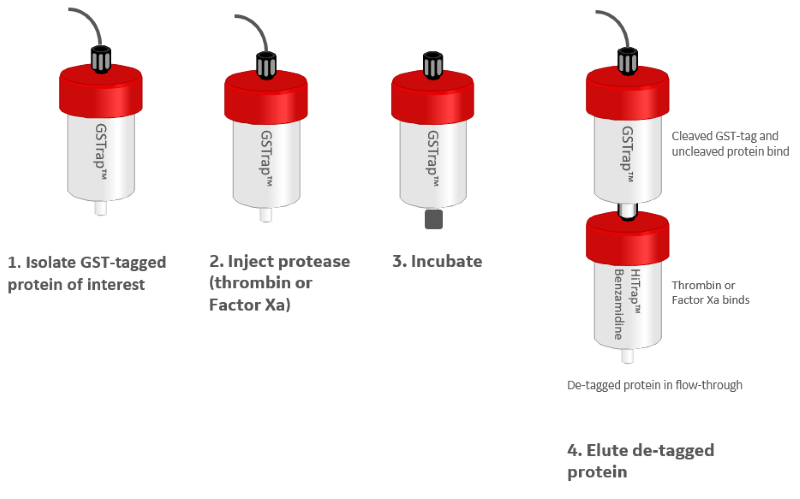Based on responses from happy scientists, we are sharing these automated methods for removing an affinity tag and the protease. The tag is cleaved while the protein is still bound to the affinity resin. The next step depends on the protease. Thrombin or Factor Xa is removed by connecting a second (Benzamidine) column. Tagged proteases are removed on the same column as used for capture.
An affinity tag can be cleaved from your target protein by first eluting the protein from an affinity resin and then adding a protease. But that option is time-consuming and requires extra handling. A convenient and automated option is to remove both the tag and the protease using on-column cleavage and a chromatography system.
Different approaches are possible depending on the protease used. Non-tagged proteases such as thrombin or Factor Xa can be removed using a Benzamidine resin, which binds to serine proteases.
Tagged proteases can be removed with the same affinity chromatography resin/column used to capture the tagged protein of interest. For example, histidine-tagged TEV (tobacco etch virus) proteases are commonly used to cleave tags from histidine-tagged (his-tagged) target proteins and can easily be removed by an IMAC (immobilized metal affinity chromatography) column. And GST-tagged HRV3C (human rhinovirus 3C) proteases, such as PreScission Protease, can be used to cleave GST-tagged proteins and removed by a glutathione affinity column.
To minimize handling and maximize speed in all the procedures, we recommend attaching columns to a chromatography system such as an ÄKTA system. Purification can also be performed using a syringe or a simple pump.
GST-tagged proteins: remove tag and thrombin or Factor Xa
1. Isolate your GST-tagged protein using a glutathione affinity column, such as GSTrap FF column (prepacked with Glutathione Sepharose Fast Flow resin). Wash out unbound protein with binding buffer. Then equilibrate the column with the optimal cleavage buffer for thrombin or Factor Xa.
2. Inject the protease into the GSTrap column and seal both ends.
3. Incubate for 2 hours at room temperature (or a suitable time for an optimal yield of cleaved target protein).
During the incubation, equilibrate a HiTrap Benzamidine FF (high sub) column (prepacked with Benzamidine Sepharose Fast Flow) with the recommended binding buffer. Connect the GSTrap column on top of the HiTrap Benzamidine column.
4. After incubation is complete, wash the connected columns with binding buffer.
This procedure allows the cleaved protein and thrombin or Factor Xa to be washed out from the GSTrap FF column. As the sample passes through the connected HiTrap Benzamidine column, the protease will bind. However, the de-tagged protein will pass through the column for collection in the flow-through.

Read about how this procedure was used with thrombin and GST-tagged human αSyn or GST-tagged SH2.
His-tagged proteins: remove tag and thrombin or Factor Xa
The previous procedure can also be used with his-tagged proteins.
1. Isolate your his-tagged protein on a nickel- or cobalt-IMAC column, such as HisTrap HP or HiTrap TALON crude, respectively. Wash out unbound protein with binding buffer. Then equilibrate the column with the optimal buffer for thrombin or Factor Xa cleavage.
2. Inject thrombin or Factor Xa protease into the IMAC column and seal both ends.
3. Incubate for 2 hours at room temperature (or a suitable time for an optimal yield of cleaved target protein).
During the incubation, equilibrate a HiTrap Benzamidine FF (high sub) column with the recommended binding buffer. Connect the IMAC column on top of the HiTrap Benzamidine column.
4. After incubation, wash the two connected columns with the buffer used to equilibrate the Benzamidine column.
The purified, de-tagged protein will flow through both columns. Another advantage to using this procedure is that it avoids imidazole elution and subsequent buffer exchange.
His-tagged proteins: remove tag and his-tagged protease
The following procedure uses the same affinity column for target protein purification and protease removal.
1. Isolate your his-tagged protein using a nickel- or cobalt-charged IMAC column, such as HisTrap HP or HiTrap TALON crude, respectively. Wash out unbound protein with binding buffer. Then equilibrate the column with the optimal buffer for cleavage using his-tagged TEV protease.
2. Inject the protease and seal the column.
3. Incubate for 15 hours at 4°C, which is the optimal cleavage temperature for TEV protease.
4. After incubation, restart the flow and wash the column with cleavage buffer.
The de-tagged protein will pass through and is collected. The his-tagged protease, cleaved his-tag, and any uncleaved target protein will remain bound on the column.

GST-tagged proteins: remove tag and GST-tagged protease
The previous procedure can be performed in a similar way for GST-tag cleavage using PreScission Protease. Simply substitute a GSTrap column for the charged IMAC column.
Sign up for the ÄKTA club newsletter Learn more about protein purification